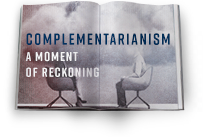Complementarianism: A Moment of Reckoning
Part 1: Today’s Tension: Broad Versus Narrow Complementarianism
Part 2: Different Intuitions and Pastoral Burdens
Part 3: How Do We Move Forward? A Better Understanding of Authority and Equality
Part 4: How Do We Move Forward? A Better Understanding of Abuse and Gender
Part 5: How Do We Move Forward? A Re-Commitment to the Sufficiency of Scripture
* * * * *
Part 1: Today’s Tension: Broad Versus Narrow Complementarianism
It seems to be a moment of reckoning for complementarianism. One can tell since the loudest questions aren’t being asked from outside the camp, but from inside. Authors like Rachel Green Miller have quipped, “Am I complementarian? I used to think so.” [1] Complementarian Aimee Byrd’s forthcoming title communicates the same ambivalence: Recovering from Biblical Manhood and Womanhood. The title riffs on one of the foundational texts of complementarianism: Recovering Biblical Manhood and Womanhood.
Beth Moore might be the most well-known personality who, while claiming membership in the camp, has recently offered her share of critiques.
I don’t know. Call me crazy but I tend to be reluctant to trust any man who is obsessed with the submission of women.
— Beth Moore (@BethMooreLPM) November 19, 2019
She says she respects a number of conservative complementarians, but doesn’t understand their interpretations of Scripture, and worries they miss the Bible’s bigger picture regarding women.
Is to grapple with the entire text from Mt 1 thru Rev 22 on every matter concerning women. To grapple with Paul’s words in 1 Tim/1 Cor 14 as being authoritative, God-breathed!- alongside other words Paul wrote, equally inspired & make sense of the many women he served alongside.
— Beth Moore (@BethMooreLPM) May 11, 2019
Yet the real problem, says Moore, goes well beyond differences over how to read the Bible. According to Moore, some? many? most? complementarian men are driven by misogyny, sexism, and the abuse of power, at least within the Southern Baptist Convention.
I had the eye opening experience of my life in 2016. A fog cleared for me that was the most disturbing, terrifying thing I’d ever seen. All these years I’d given the benefit of the doubt that these men were the way they were because they were trying to be obedient to Scripture…
— Beth Moore (@BethMooreLPM) May 11, 2019
Here is what you don’t understand. I have loved the SBC & served it with everything I have had since I was 12 years old helping with vacation Bible school. Alongside ANY other denomination, I will serve it to my death if it will have me. And this is how I am serving it right now.
— Beth Moore (@BethMooreLPM) May 11, 2019
She doesn’t specify who she is indicting with sexism and misogyny. Her indictment remains broad enough to suggest—perhaps unintentionally—that complementarianism itself might be driven by these things. At the very least, her comments put complementarians on the defensive: “Wait, I’m not that kind of complementarian, am I?”
The uncertainty or discomfort with complementarianism among complementarians is bigger than Moore. Step into a group of complementarians these days and it’s likely that one or more will say something about not being that kind of complementarian. Usually the target is someone to a person’s political, theological, or temperamental right, and often the challenge feels generational— it’s a second generation of complementarians wondering about their teachers. Insofar as the organization the Council on Biblical Manhood and Womanhood and its writers embody that first generation, they are often the target of such challenges.
Few if any of these in-house critiques challenge the Danvers Statement, which is the charter document that CBMW exists to promote. Nor do people engage with the arguments in Recovering Biblical Manhood and Womanhood. Rather, a social media brushfire typically begins somewhere on the periphery of the camp. A first-generation complementarian like John Piper might oppose women teaching in seminaries or women as police officers. Or Martha Peace will offer an illustration about submitting to her husband by washing dishes (that article has since been removed). A week-long Twitter fire then erupts. The second generation finds such applications of shared biblical principles beyond the pale, and their suspicion grows. Then the quip: “I’m not that kind of complementarian.”
Among a few, that suspicion was exacerbated by the 2016 controversy over the doctrine of the eternal subordination of the Son to the Father since a couple of well-known first-generation complementarians defended it. (CBMW president Denny Burk has argued on a number of occasions that this doctrine has never been a part of complementarianism).
Among a few more is the always-recyclable and always-relevant argument that contemporary presentations of complementarianism aren’t so much biblical as they are expressions of someone’s culture: “Complementarianism emerges from concerns unique to Christians in the Boomer generation.” “It’s a product of Victorian and Roman views of gender.” And so forth.
Perhaps most widely of late are the worries that complementarianism, by placing too much emphasis on male authority, demeans women or even leads to their abuse, as suggested in Moore’s tweets above. The bloggers ask, why is theologian Wayne Grudem only now, after 40 years of defending complementarianism, acknowledging that abuse can provide biblical grounds for divorce? And why did John MacArthur so disdainfully tell Beth Moore to “go home”?
Whatever one makes of these particular anecdotes, seminary president and stalwart complementarian Albert Mohler himself remarked that male superiority and failing to correct abuse are two blind spots complementarians need to do a better job of addressing.
BROAD VERSUS NARROW COMPLEMENTARIANISM
As mistrust and divisions grow inside a camp—sad to say—so does the need for adjectives which label a camp’s separate corners. One article pits minimalist against maximalist complementarianism. Others distinguish between hard and soft. My friends at the Village Church in Texas refer to theirs as a generous complementarianism.
I prefer the language of broad and narrow. It’s both descriptive and means to be non-prejudicial to either side.
Yet let’s first back up. If the big fight in the 1980s and 90s was between egalitarians and complementarians, that fight isn’t on the forefront today, at least in my denominational and theological circles. Many who belonged to that older egalitarian stream have since recused themselves from the “evangelical” conversation. Now they are LGBT-affirming and are no longer happy to own the evangelical label. One-time evangelical egalitarians like Tony Campolo and David Gushee provide prime examples. Even when the egalitarians of that earlier era remain faithful to the Bible’s teaching on sexuality, many (thankfully, not all) of their students and disciples have moved (contrary to the older generation’s desires) in an LGBT-affirming direction. Sexuality and gender are hard to separate, both conceptually and hermeneutically (see Colin Smothers’ Journal article on this).
Today, the tension between broad and narrow corners of the complementarian camp sits on the front burner. The nomenclature of broad and narrow serves to designate how broadly or narrowly the discipleship mandates of complementarianism go. Outside the church and home, broad complementarians are more likely to say the differences between men and women apply broadly in all of life, such as in the workplace. They may not agree on every application, such as whether women can teach in seminaries or be police officers. But all broad complementarians affirm that the basic differences between men and women root in divine design and therefore impact Christian discipleship in all of life, at least as a matter of wisdom if not moral principles. No woman or man is morally bound to this or that job or life decision, and God has designed every individual uniquely. Exceptions always exist. Still, different design patterns generally create different platforms. Gender is a gift and an opportunity everywhere. Therefore, Christian discipleship involves enquiring into the nature of that gift.
Narrow complementarians also affirm the fact of design differences. Yet their writings and statements tend to shy away from defining those differences or treating them as discipleship matters. They’re rightly seeking to avoid wrongly binding consciences with cultural stereotypes, and then calling that the standard of Christian maturity. This is always a legitimate concern. They’ll acknowledge that God designed men and women differently, but they won’t quite say what those differences are. They won’t fill in the blanks at the end of these sentences: “Men are ___” or “Manhood is ___” or “Femininity is ___.”
Turning to the inside of the church and home, broad and narrow complementarians agree on the basic biblical principles, but they tend to apply those shared principles differently (though see Joe Rigney’s challenge here, which is not without merit). In the church, a broad complementarian is probably less likely to make room for a woman teaching a mixed-gender Sunday School class, while a narrow complementarian will likely make more room. In the home, a broad complementarian couple will probably work harder at living on one income so that a mother can remain home when the children are young. A narrow complementarian couple will probably work harder at pursuing vocational opportunities for the mother outside the home while employing daycare for the children. I’m not saying these descriptions describe everyone in a given corner; I’m saying these are the tendencies I’ve witnessed.
To be sure, many complementarians defy easy categorization as either fully broad or fully narrow. A person might have broad convictions at church and narrow ones at home. Or a person might combine both broad and narrow instincts in both. For instance, writer and speaker Jen Wilkin talks at length about design differences (broad). She is unafraid to fill in the blanks on “Men are ___” and “Women are ___” and builds her argument for single-sex learning environments off of those differences. Yet she also pushes hard at programmatizing female leadership in the church without necessarily defining the nature of that leadership (narrow).
* * * * *
Read Part two here.









